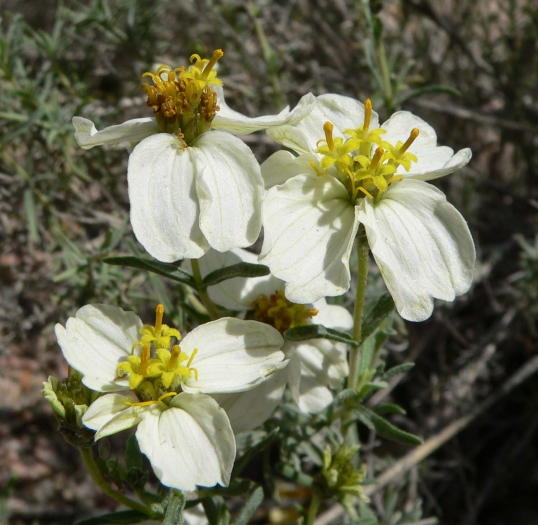Desert Zinnia
(Zinnia acerosa)
Desert Zinnia (Zinnia acerosa)
/
/

Stan Shebs
CC BY-SA 3.0
Image By:
Stan Shebs
Recorded By:
Copyright:
CC BY-SA 3.0
Copyright Notice:
Photo by: Stan Shebs | License Type: CC BY-SA 3.0 | License URL: https://creativecommons.org/licenses/by-sa/3.0 | Uploader: Stan Shebs | Publisher: Wikimedia Commons | Title: Zinnia_acerosa_flowers.jpg | Notes: |





















































Estimated Native Range
Summary
Zinnia acerosa, commonly known as Desert Zinnia, is a perennial subshrub or herb that is evergreen or semi-deciduous, native to desert scrub, grasslands, and open areas in the Southwestern USA and Northwestern Mexico. It is a drought-tolerant plant that typically grows up to 16 cm (6.4 inches) tall, with a similar spread, forming a low, mounding habit. The leaves of Desert Zinnia are very narrow, sometimes needle-shaped, up to 2 cm (0.8 inches) long, and covered with fine hairs that help reduce water loss. From late spring to early fall, it produces solitary flower heads on each stem, each head with 4-7 yellow or white ray florets encircling 8-13 yellow or purple disc florets. The flowers are modest in size but can be quite showy due to their abundance and the contrast against the foliage.
Desert Zinnia is valued for its resilience to hot, dry conditions and its extended blooming period, making it an excellent choice for xeriscaping, rock gardens, and as a ground cover in arid landscapes. It is also appreciated for its ability to attract butterflies and other pollinators. In cultivation, it thrives in full sun and requires minimal water once established, preferring well-drained soils. While it is generally low-maintenance, it can be susceptible to root rot if overwatered or planted in poorly drained soils.CC BY-SA 4.0
Desert Zinnia is valued for its resilience to hot, dry conditions and its extended blooming period, making it an excellent choice for xeriscaping, rock gardens, and as a ground cover in arid landscapes. It is also appreciated for its ability to attract butterflies and other pollinators. In cultivation, it thrives in full sun and requires minimal water once established, preferring well-drained soils. While it is generally low-maintenance, it can be susceptible to root rot if overwatered or planted in poorly drained soils.CC BY-SA 4.0
Plant Description
- Plant Type: Subshrub, Herb
- Height: 0.6-1 feet
- Width: 1-1.5 feet
- Growth Rate: Moderate
- Flower Color: White
- Flowering Season: Spring, Summer, Fall
- Leaf Retention: Evergreen
Growth Requirements
- Sun: Full Sun
- Water: Low
- Drainage: Fast
Common Uses
Bank Stabilization, Bee Garden, Bird Garden, Border Plant, Butterfly Garden, Deer Resistant, Drought Tolerant, Hummingbird Garden, Low Maintenance, Potted Plant, Rabbit Resistant, Rock Garden, Showy Flowers
Natural Habitat
Native to desert scrub, grasslands, and open areas in the Southwestern USA and Northwestern Mexico
Other Names
Common Names: Wild Zinnia, White Zinnia, Spinyleaf Zinnia, Shrubby Zinna, Southern Zinnia
Scientific Names: , Zinnia acerosa, Zinnia pumila, Diplothrix acerosa, Crassina pumila, Crassina acerosa,
GBIF Accepted Name: Zinnia acerosa (DC.) A.Gray